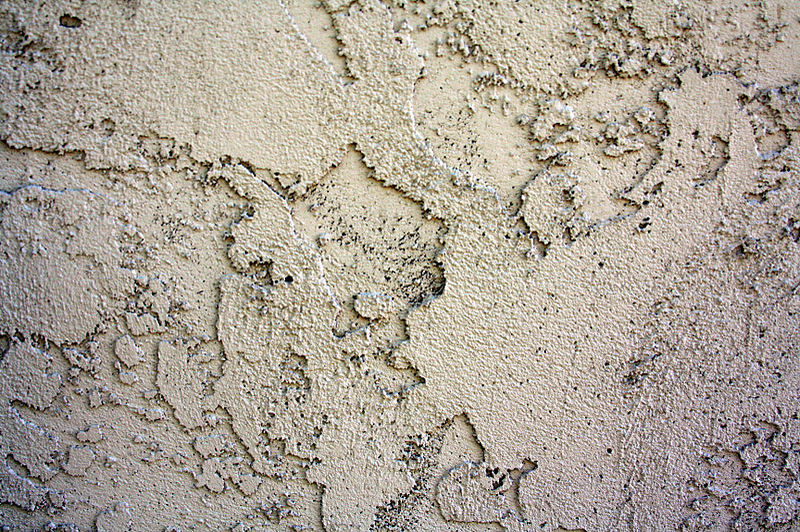When left untreated, water-damaged stucco can result in costly fines. This article will teach you how to repair water damaged stucco through five simple steps: assessing, determining, removing, prepping, and patching.

What is stucco?
Stucco is the name for a construction material made of aggregates, a binder, and a little water. In some places, some people also refer to it as render.
Traditionally, stucco is made by combining lime, sand, and water. Nowadays, it is more popular to use cement such as Portland cement, sand, and water to create stucco. Builders can add glass and acrylic to improve the material’s structural integrity.
When used for the outside facade of a structure, it is called stucco. However, when it is used for the interior, it is sometimes called plaster.
Stucco is applied wet but hardens to a dense and robust solid. In construction, it has many uses.
People in the construction business also use this material as a decorative coating for walls, ceilings, and even metal. It also has benefits as a sculptural and artistic medium.
Another great thing about this material is its versatility. It can be applied to almost anything: cinder blocks, metal, concrete, and even clay!
Stucco also comes in many colors. Traditional lime stucco is white, but Portland cement stucco is grey. Thanks to innovations in manufacturing, though, stucco now comes in a range of colors to fit any construction project.
How Do You Repair Water Damaged Stucco?
Because stucco is also used for the exteriors of structures, the material can be exposed to harsh weather. This condition makes stucco susceptible to water damage.
Water-damaged stucco can manifest in a handful of ways. It can be something as subtle as tear-like stains where the material meets joints.
Other times, it can be cracks, dark streaks, and discolored patches. At worst, mold growth and bubbles can be observed at the site of water damage.
The key to resolving this issue is time. Catching water damage before it becomes worse is essential to salvaging stucco. Below are the steps to repair water-damaged stucco.
Step #1. Assess
Before anything else, take a long, hard look at the section of stucco. Are there any visible signs of the stucco suffering from water damage? Look for dark spots and discolorations.
Touching the surface can also help identify water damage. It may feel damp and soft, unlike undamaged stucco, which is hard and dense.
Step #2. Determine the extent of damage
This part is crucial when trying to repair water-damaged stucco. Determine whether you can fix the damage yourself or if you’ll need to call in a professional to handle the project.
If you think the damage is too substantial for a minor repair, it is best to seek professional help or go over your insurance rather than do it yourself and risk further damage.
Your insurance coverage should include water damage. Contact your lawyer if you’re unsure. If the damage isn’t too extensive, you can continue with the next set of steps.
Step #3. Remove the damaged section
After determining whether you can fix the damage without professional help, the next thing to do is to remove the damaged section. The most recommended way to do this is by using a hammer and a cold chisel.
Remove the damaged stucco by tapping it away using the tools. Typically, the broken stucco should come off without much effort.
Be careful not to scratch the underlying lath or sheathing with the chisel, as this can cause further damage in the long run. Once you’ve reached the part of the stucco that adheres firmly to the backing, stop chiseling.
Step #4. Prepare the surface
After removing the damaged portion, you will be left with a gaping hole in the middle of your stucco. To resolve this, patch the area with a stucco mix. Make sure that it matches the old stucco so that it still looks smooth and clean.
Check for any cracks on the surface where you are applying the stucco. Make sure to cover these imperfections. Afterward, give the surface a thorough cleaning to avoid further internal damage.
Step #5. Patch
Once you have prepped the surface, apply the stucco base coat using a square trowel held at a 45-degree angle. Start applying from the bottom up, using steady and even pressure. Let this coat cure for 24 to 48 hours.
Apply another layer of the base coat using the same technique. Allow the coat to cure for 24 to 48 hours.
The final coat should use the colored stucco. Apply using the same technique. You should dampen the last layer for several days as it dries to prevent any cracks.
Why is water damage bad for stucco?
Water damage can be very problematic when it comes to stucco. It can become a breeding ground for mold, which causes allergies and is the reason for cracks around windows and doors. Both of these can compromise the structural integrity of a building.
Conclusion
Water damage can be a costly nightmare. However, thanks to this post, you now know how to repair water damaged stucco.

Stucco is a material that is often used to give houses a more interesting, more textured facade, but over time, it can start to acquire cracks. Cracks can lead to whole chunks of stucco falling off of your house, and if you want to keep this repair job minimal, you’ll find that it is always important to make sure that you take care of cracks sooner than later.
Stucco is a long-lasting and attractive exterior finish, but it isn’t indestructible. Every five to ten years, stucco should be painted. To repair stucco, spread and texture the concrete patch to resemble the surrounding stucco, then level it off using a trowel. NOTE: Pre-mixed stucco fix should be put in many layers over 1/4 inch thick patches or cracks, allowing each layer to cure before applying the next.